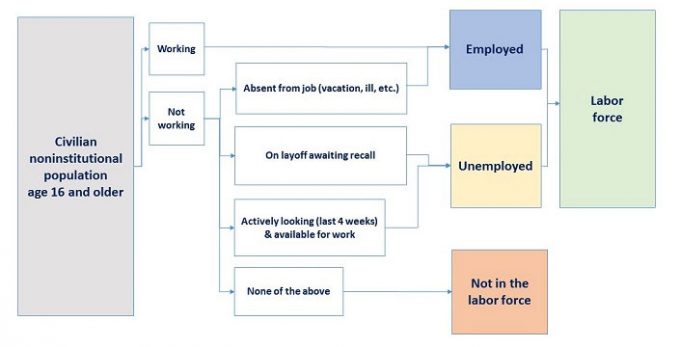By Valorie H. Rice, Senior Specialist, Business Information
With the April U.S. Employment Situation data coming out this week, it is a good time to review the information included in that report. It includes data for employment based on two measures: household data and establishment data. Establishment data are based on information from employers and is broken down by industry. The household data provides the labor force and unemployment rates, and that is the focus of this article.
The household data are derived from a monthly sample survey of households conducted by the U.S. Census Bureau for the U.S. Bureau of Labor Statistics called the Current Population Survey (CPS). The survey asks respondents about their work experience for the week of the 12th.
In the household survey data, there are three main categories which respondents fall into: employed, unemployed, and not in the labor force. In the simplest terms, an employed person has a job, an unemployed person does not have a job but is available and actively looking for work, and a person not in the labor force does not have a job and is not actively looking for one. The labor force is the sum of employed and unemployed persons (if you are in the labor force, you either have a job or are actively looking for one).
Household data starts with the civilian noninstitutional population. This is the population age 16 years and over residing in the U.S. that are not active duty military (hence the term civilian), and are not inmates of institutions (examples are prison, mental facilities and nursing homes). This is broken down to the civilian labor force and those not in the labor force. The civilian labor force is the sum of those employed and unemployed. Those not in the labor force include people who are not working and have not actively looked for work in the last four weeks. Examples would be people who are retired, full-time students, or stay-at-home parents. The official (U3) unemployment rate is the number of unemployed people as a percentage of the labor force. The employment-population ratio is the percent of the population currently working or the number of employed as a percentage of the civilian noninstitutional population. This indicator will be an important complement to the unemployment rate in coming months.
Who is considered employed? This would be anyone who worked at a paid position, worked at their own business or farm, or worked 15 hours or more as unpaid workers for an enterprise operated by a member of the family. Thus, it does include the self-employed.
People who have multiple jobs are counted just once. Volunteer work and unpaid internships are not considered employment. People with a job but who were not at work during the reference week because of these temporary reasons are still considered employed whether they are paid for that time or not: vacation, illness, bad weather, childcare problems, maternity or paternity leave, labor-management dispute, job training or other family or personal reasons.
Who is unemployed? To be unemployed, a person must meet three criteria: 1) not employed during the reference week, 2) were available to work during that period (except for temporary illness), and 3) made at least one specific effort to find a job within the last four weeks or are temporarily laid off and expecting to be recalled to your job. A person’s eligibility or receipt of unemployment benefits has no bearing on their classification as unemployed.
What about furloughs? A person who does not work during the reference week because of a furlough or temporarily laid off counts as unemployed.
Exhibit 1 is a diagram from the Bureau of Labor Statistics explaining employment, unemployment and not in the labor force. If you prefer video, here is a nice one that covers the same concepts from the BLS.
Exhibit 1: Classifying Respondents to the BLS Household Survey






